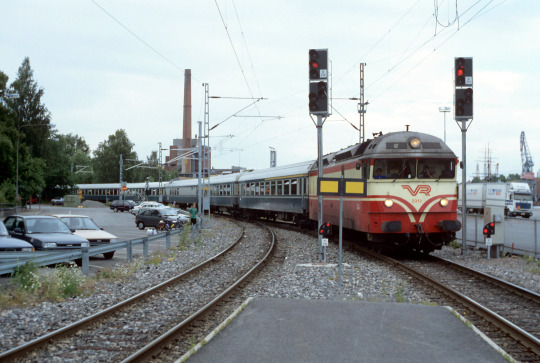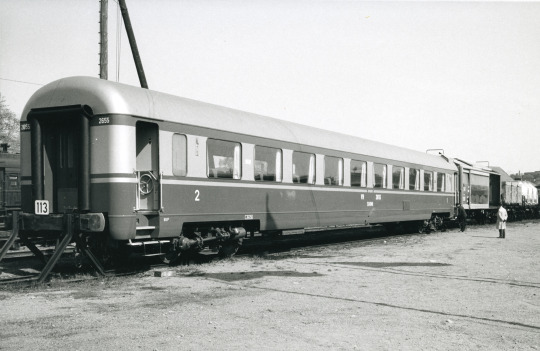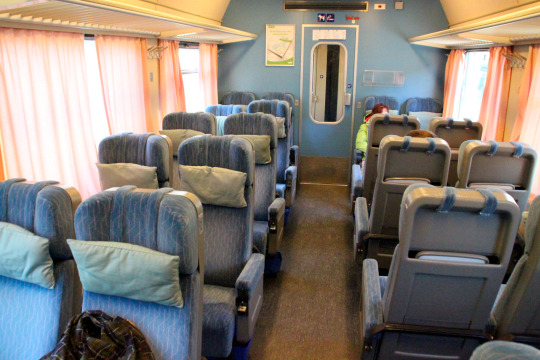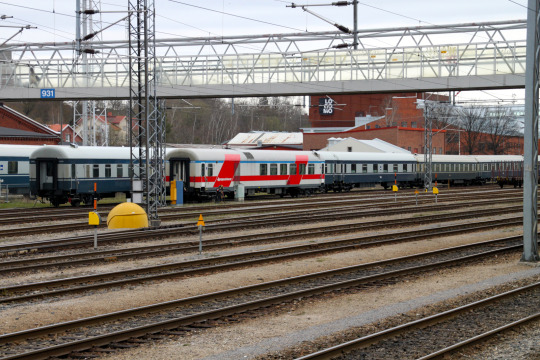#toki saatto se vaikuttaa että sillon oli 19v ja nyt ei enää oo
Explore tagged Tumblr posts
Text
Siniset vaunut kulki aika pitkään Itä- ja Pohjois-Suomen raiteilla. Jos sattu hyvä säkä luentojen aikataulujen kanssa ja pysty lähtemään päivän Savoon suuntaavista kolmesta vuorosta sillä ainoalla suoralla, niin sinisten vaunujen penkeillä saatto nukkua suunnilleen koko Rovaniemi-Iisalmi -välin. Ei muuten onnistu IC-vaunun penkillä se. Trust me bro, I tried.
Legendaarisia hetkiä myös kun sinisen vaunun Junan Vessa ™ oli pöntön kautta imassu niin paljo pölisevää lunta sisään, että kokemus vastas lähinnä kusitaukoo hangessa. : D
An introduction to VR passenger carriages, part 1: the blue carriages
In our next series of introducing our rolling stock, we will be looking at passenger carriages. I was actually thinking of doing multiple units next, but @hapotonradio requested I do the blue carriages and a lot of people seemed to like the idea so here we go.

A Dr13-hauled train consisting of blue carriages arriving in Turku Harbour, 1995. Falk1, Wikimedia Commons
I can already hear foreigners (and non-rail enthusiast Finns too) going "what the hell are the blue carriages?" Well, the blue carriages were/are the first Finnish steel-bodied passenger carriages, with over 600 units (depending a bit on what you count as being actual blue carriages) of different types built between 1961 and 1986. Today, almost all of them have been retired. Which is a shame, because they were sexy.
The first 15 blue carriages were built by the West German Maschinenfabrik Esslingen, who also designed them, in 1961. This original batch were equipped with different types of boggies, from which the Minden-Deutz boggie was chosen for the eventual mass-produced series built in-house by the VR Pasila workshop starting from 1964 (Valmet also built a small number of carriages).

A combined 1st and 2nd class carriage as built, 1964. At this point they still had steel covering the underbody from the sides. These hems were later removed to better display the arousing technical bits. Olavi Karasjoki, Suomen rautatiemuseo.

President Kekkonen (the bald dude) visiting the above carriage. Olavi Karasjoki, Suomen rautatiemuseo.
The initial batch consisted of ten 2. class carriages (littera Eit), four combined 1. and 2. class coaches (lit. CEit) and one 1. class coach (lit. Cit). As you can maybe figure out, the -t at the end stood for teräs, steel, to distinguish from the old wood-bodied coaches. In addition to the regular first- and second-class coaches, the blue carriages' base design was adopted for restaurant cars (litteras Rbkt, Rt, Rkt and Rk), combined condutor's and luggage cars (lits. Fot, Efit and Efiti), sleepers (CEmt), aggregate cars to use on non-electrified tracks (Eifet), carriages with children's playrooms (ELht), postal carriages (Pot), military transport (Ems), prisoner transport (Nom), special carriages for the president and cabinet (A), and even a one-off disco carriage. The latter in particular fucked severely. All those sweaty bodies having it on inside a train...
Some sources also list the Eil-class local traffic coaches as blue carriages, but since they had some structural differences and were originally painted red rather than blue, I'm going to cover them in a separate entry.

Interior of a 2nd class carriage. My photo
Over the quarter of a century the blue carriages were in production, numerous improvements were made to the original design; most notably, the original top service speed of 120 km/h was increased first to 140 km/h and then to 160 km/h in some units.
By the time the last blue carriages were delivered in 1986, their star was already waning. In 1988, the first new Intercity carriages (in a white and red IC delivery) were delivered, and Intercity trains replaced the blue-carriaged special express (erikoispikajuna) trains as the flagship product. With the arrival of the Intercity carriages, and the double-decker carriages from 1998 onwards, the blue carriages were phased out.

Blue carriages at the Turku depot, an Eifet aggregate car repainted in the Intercity livery in the 1990s and CEmt sleepers (both carriages visible behind the Eifet; the sleepers have asymmetric window arrangements). My photo
Today, the only blue carriages still in use in the iconic original livery as sleepers in night trains to Lapland, and prison transport carriages. Some restaurant cars, aggregate cars and conductor's carriages still exist, but they have been repainted in the newer liveries. Several blue carriages have also been preserved by different instances and they're relatively commonly seen in heritage/museum trains these days.
#legendary shit#siniset vaunut oli parasta#vaikka ois nukkunu selkä mutkalla käsinojaa vasten niin fiilis oli autuas#toki saatto se vaikuttaa että sillon oli 19v ja nyt ei enää oo#tai sitte ne vaunut oli vaan niin hyviä#JA SE HATTUHYLLY#sinne mahtu puoli maailmaa#ei mahu uusissa vaunuissa#perkele
57 notes
·
View notes